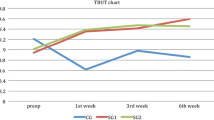Abstract
Purpose: To assess the level of awareness among UK ophthalmic surgeons of the potential risks from starch powdered surgical gloves during ophthalmic surgery and to show by electron microscopy that starch granule contamination can occur during ophthalmic surgery. Setting: A sample (N = 46) of UK ophthalmologists from the North of England, UK. Methods: Type of glove usage and awareness of the possible risks from starch powdered surgical gloves were assessed by means of a questionnaire sent to ophthalmic surgeons in the North of England. The surface of a polymethylmethacrylate (PMMA) intraocular lens (IOL) handled with a starch powdered surgical glove was examined by electron microscopy for evidence of starch contamination. Results: Of the sampled ophthalmic surgeons (46), 89.1% considered it important to use starch free surgical gloves and the 84.8% already did so. Starch granule contamination was seen by electron microscopy on the surface of a PMMA IOL which had been handled with starch powdered surgical gloves. Conclusions: Although there has been sporadic attention in the ophthalmic literature to the risks associated with starch powdered surgical gloves in ophthalmology, up to 15% of UK ophthalmic surgeons may still be using starch powdered gloves. The authors show that starch powder contamination of ophthalmic materials can actually occur and remind ophthalmologists that this has been reported in the literature as a possible cause of sterile intra and extraocular inflammation.
Similar content being viewed by others
References
Ramsey TL, Douglas FM. Granulomatous inflammation produced by foreign body irritants. J Int Surg 1940; 3(3): 3-10.
German WM. Dusting powder granulomas following surgery. Surg Gynec Obst 1943; 76: 501-507.
McEntee GP, Stuart RC, Bryne PJ, Leen E, Hennessy TP. Experimental study of starch induced intraperitoneal adhesions. Br J Surg 1990; 70(10): 1113-1114.
Liujendijk RW, de Lange DC, Wauters CC, Hop WC, Duron JJ, Pailler JL, Camprodon RB, Holmdahl L, van Geldrop HJ, Jeekel J. Foreign material in postoperative adhesions. Ann Surg 1996; 223(3): 242-248.
Holmadhl L, al Jabreen M, Xia G, Risberg. The impact of starch powdered gloves on the formation of adhesions in rats. Eur J Surg 1994; 160(5): 257-261.
Ellis H. The hazards of surgical glove dusting powders. Surg Gynecol Obstet 1990; 171(6): 521-527.
Edlich RF. A plea for powder-free surgical gloves. J Emergency Med 1994; 12(1): 69-71.
Scott-Coombes DM, Vipond MN, Thompson JN. General surgeons’ attitudes to the treatment and prevention of abdominal adhesions. Ann R Coll Surg Engl 1993; 75(2): 123-128.
Treutner KH, Bertram P, Loser S, Winkeltau G, Schumpelick V. Prevention and therapy of intra-abdominal adhesions. A survey of 200 clinics in Germany. Chirurg 1995; 66(4): 398-403.
McCormick OL, Macauley WL, Miller GE. Talc granulomas of the eye. Am J Ophthalmol 1949; 32: 1252-1254.
Chamlin M. The effect of talc in ocular surgery. Arch Ophthalmol 1945; 34: 369-373.
Schwartz FE, Linn JG. The effect of glove powders on the eye. Am J Ophthalmol 1951; 34: 585-592.
Egger SF, Huber-Spitzy V, Schilda C, Schneider B, Grabner G. Bacterial contamination during extracapsular cataract extraction. Prospective study on 200 consecutive patients. Ophthalmologica 1994; 208(2): 77-81.
Assalian A, Thompson P, St. Antoine P, Lemire J, Duperre J, Demers JP, Gauvin P. Anterior chamber fluid contamination after uncomplicated phacoemulsification. J Cataract Refract Surg 1995; 21(5): 539-542
Samad A, Solomon LD, Miller MA, Mendelson J. Anterior chamber contamination after uncomplicated phacoemulsification and intraocular lens implantation. Am J Ophthalmology 1995; 120(2): 143–150.
Parelman AG. Sterile uveitis and intraocular lens implantation. Am Intraocular Implant Soc J 1979; 5: 301-306.
Drolsum L, Davanger M, Haaskjold E. Risk factors for an inflammatory response after extracapsular cataract extraction and posterior chamber. IOL Acta Ophthalmologica 1994; 72(1): 21-26.
Busin M, Meller D, Cusumano A, Spitznas M. Chronic low grade endophthalmitis. A growing indication for explantation of intraocular lenses. Ophthalmologe 1994; 91(4): 473-478.
Aronson SB. Starch endophthalmitis. Am J Ophthalmol 1972; 73(4): 570-578.
Bene C, Kranias G. Possible intraocular lens contamination by surgical glove powder. Ophthalmic Surg 1986; 17(5): 290-291.
Vafidis GC, Marsh RJ, Stacy AR. Bacterial contamination of intraocular lens surgery. Br J Ophthalmol 1984; 68: 520-523.
Karcioglu ZA, Aran AJ, Holmes DL, Kapicioglu Z, Lopez J. Inflammation due to surgical glove powders in the rabbit eye. Arch.Ophthalmol 1988;.106:. 808-881.
Driebe WT, Mandelbaum S, Forster RK, Schwartz LK, Culbertson WW. Pseudophakic endophthalmitis. Diagnosis and treatment. Ophthalmology 1986; 93: 442-448.
Smith RE. Inflammation after cataract surgery. Am J Ophthalmol 1986; 102(6): 788-790.
Oh Y, Katz J, Spaeth GL, Wilson RP. Risk factors for the development of encapsulated filtering blebs. The role of surgical glove powder and 5-fluorouracil. Ophthalmology 1994; 101: 629-634.
English FP, DiMarco A. Talc powder granules. Ocular Surg News 1996; Mar(3): 5.
Aran AJ, Lopez JG, Karcioglu. Talcum particles on surgical gloves: quantitative analysis of cleaning methods. Invest Ophthalmol Vis Sci 1984; 25: 170.
Villasenor RA, Harris DF, Barron GJ, Krasnow M, Salz JJ. Powderfree surgical gloves. Ophthalmic Surg 1984; 15(3): 241-243.
Author information
Authors and Affiliations
Rights and permissions
About this article
Cite this article
Sellar, P.W., Sparrow, R.A. Are Ophthalmic Surgeons Aware that Starch Powdered Surgical Gloves are a Risk Factor in Ocular Surgery?. Int Ophthalmol 22, 247–251 (1998). https://doi.org/10.1023/A:1006392915801
Issue Date:
DOI: https://doi.org/10.1023/A:1006392915801




